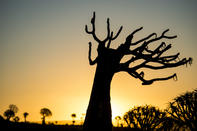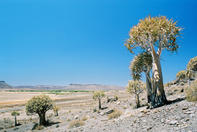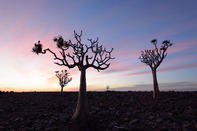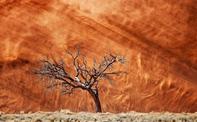Nieuwoudtville
When Foden's team included the factors of altitude and latitude in the equation, a pattern emerged. Trees in the far north and at lower altitudes showed the highest mortality, while those that occurred further south and at a higher elevation were healthier.

Just as environmental scientists have been predicting, these trees are showing signs of taking refuge in envelopes of comfortable habitat. They are retreating to higher altitudes, on cooler mountain slopes, while the low-lying trees are dying.
The trees also appear to be 'moving' southward as their bioclimatic envelope shifts south. Until now, the quiver tree's southern range has probably been limited near Nieuwoudtville in the Northern Cape by higher rainfall and fungus. But, as the desert moves south, so are the trees. When we talk about plants shifting their range, bear in mind that they are not like animals which can simply uproot and physically move. The only way for a plant to shift its range is to become extinct at one extreme of its range while seedlings begin to propagate successfully at the other extreme.
The quiver tree appears to be dying out in its northern range in Namibia and thriving down south in areas such as Nieuwoudtville in South Africa. In case any doubt emerged about the interpretation of the data collected by Foden and her colleagues, her team resurrected photographs taken of quiver trees during the previous century. Painstakingly they visited the site of each photograph, found exactly the same vantage point, and re-shot the picture.
Comparing the old pictures with recent ones, they were able to confirm their findings. By counting trees in the photographs, they were able to see that populations in the far south, near Calvinia, showed an increase of about 110 per cent, while populations along the Orange River showed huge decreases. They found similar changes in the distribution along altitudinal gradients. This, asserts Foden, is highly convincing evidence that a changing climate is the culprit. It's the most obvious smoking gun.
Increase in Temperature

Anecdotal evidence also supports the findings of Foden and her team. One Namibian farmer recalled growing up on a farm where quiver trees grew right from the farmhouse in a valley, up a nearby mountainside. Today, the first aloes to be encountered on that mountain occur about two-thirds of the way up its slopes.
These findings, compared with climate records, show that there is a strong correlation between the mortality rate of trees and temperature increases dating back to the 1960s. Naturally wetter and drier periods may have occurred during this time, but the overall trend is towards drying.
Temperature records from weather stations across the aloe's range in Namibia and the Northern Cape showed a mean decadal increase in temperature that is almost three times the global mean temperature increase for the twentieth century.
The Desert is Moving South

The conclusion of Foden's study is that the desert is moving south. The behaviour of this tree aloe confirms the theoretical projections about shifting bioclimatic envelopes. Before anyone began asking what climate change would mean to the arid west, these trees were already on the move and have been for at least thirty years, if not more.
Foden comments that this is probably the last place you would expect to find climate change happening. An arid system, one might think, is more likely to handle an increase in warm and dry conditions. The quiver tree is an abundant species with a wide distribution and broad climatic tolerance. Yet, despite being so hardy, it is dying out in the hotter part of its range.
More importantly, until now, this kind of plant behaviour had been limited to the realm of theory and computer modelling. 'This is a real wakeup call,' says Foden. More relevant, she points out, is what the quiver tree's experience indicates the many other species living in these parts, particularly the succulent karoo's localised endemics.
These plants do not disperse well, mostly only as far as a raindrop can propel their seeds. It's for this reason that they only occur in such small areas with highly specific climate needs.
Succulents in a Warmer World
Researchers at South African National Biodiversity Institute (SANBI), have had a closer look at what might happen to the succulents of the Knersvlakte in a warmer world. A series of transparent, open-topped chambers were erected around small patches of succulents during the spring and summer of 2002/2003 to simulate the hotter, drier conditions that the plants can expect to experience there in the next half-century.
Four months later, after exposure to an average 5.5°C hotter than the ambient temperature outside the chambers, which is close to one of the predicted increases in the area by 2080, the plants showed dramatic signs of struggle. Dwarf and succulent plants in the chambers showed a two- and five-fold greater mortality than those outside of the chambers.
This experiment exposed the plants to an abrupt increase in temperature, denying them time to acclimatise, which might explain some of the 'extraordinarily high mortalities'. Nevertheless, many plants in the hotter parts of the chambers received lethal doses of temperature.
The results from looking at the chemical properties in the leaves of those plants that survived showed that the plants' photosynthetic productivity decreased in the heat. Similar experiments on plants in the forest, grassland and tundra biomes elsewhere on the planet showed that plants were stimulated to greater productivity by the heat. Not so here. These findings suggest that these rare plants are already close to the ceiling of their ideal upper temperature.
Warming and Drying

Along with Namibia's hyper-arid environment and the high levels of endemism further south, the predicted warming and drying will worsen the extremes that are naturally occurring here, making it one of the regions most vulnerable to this change. Heating up and drying out will move the winter rainfall-dominated succulent karoo biome southwards within the next 50 years, reducing its size and exerting strong pressure on the plants in this area.
The future of species that are able to move with their shifting climatic envelope looks more rosy. In an academic exercise, the potential range shift of the species in Namibia - where the quiver tree enjoys an extensive range - was modelled and the species reclassified according to the IUCN Red Data listing process.
The species that were able to migrate well emerged as the least threatened by climate change. This exercise showed that 'more than half of the total number of species could at least be classified as vulnerable by 2050 and 2080.' Of those species that were unable to migrate in the computer simulation, 25 percent were reclassified as Critically Endangered by 2050, with a range contraction greater than 80 per cent, while five per cent were classified as Extinct.
These percentages shift significantly by 2080, with 30 per cent becoming Critically Endangered and 13 per cent Extinct. This exercise shows 'the decisive role of migration in impacting on species threat status...with an assumption of zero migration, almost half of the 834 species modelled are classified as Extinct or Critically Endangered in Namibia by 2080, but with perfect migration assumed, only a third are Extinct or Critically Endangered, and almost half are classified as Less Threatened, even by 2080'. But some plants will find it extremely difficult to track climate envelopes.
By Leonie Joubert